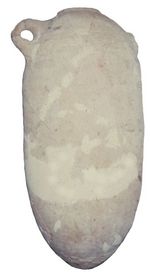Roman Amphorae: a digital resource
University of Southampton, 2005. (updated 2014) https://doi.org/10.5284/1028192. How to cite using this DOI
Data copyright © University of Southampton unless otherwise stated
This work is licensed under the ADS Terms of Use and Access.
Primary contact
Dr
David
Williams
Dept of Archaeology
University of Southampton
Avenue Campus
Highfield
Southampton
SO17 1BJ
England
Tel: 080 593032
Resource identifiers
- ADS Collection: 463
- DOI:https://doi.org/10.5284/1028192
- How to cite using this DOI
Almagro 54

Courtesy of Graeco-Roman Museum at Alexandria
Imad Khalil
Distinctive FeaturesA ‘cigar-shaped’ amphora, early (second to third century AD) examples are very wide bodied, thick-walled, with a broad sagging base (Peacock & Williams Class 48/Zemer 53). Fourth to mid fifth century AD vessels are also fairly short, but are thinner walled (Piéri, 2005: LRA 4A.2). Later fifth to early seventh century AD examples are longer and narrow-bodied, with corresponding smaller, more cone-shaped bases and steeper shoulders (Almagro 54/Peacock & Williams Class 49/Keay 54/Carthage Late Roman Amphora 4/Piéri LRA 4B). All have a short vertical band rim, early examples being tall and triangular, fourth century AD examples being more slanted and short, fifth century AD examples being small and square, and those of the late sixth and seventh centuries AD being more rounded. Loop/ring handles are attached to the shoulders. There is a wide band of heavy ridging on the shoulder, where the handles are attached, and near the base. Sometimes there are painted horizontal bands on the shoulder and lower wall (particularly early versions). Some fifth century AD variants have a narrow combed band on the upper wall. The upper shoulder and rim generally bear clay accretions: made in at least two sections, the upper part of the amphora was held in place on the wheel by wrapping a clay support around it. The same method was used to produce the other ‘classic’ Palestinian form, the ‘bag-shaped’ Late Roman Amphora 5.Early examples, c. 40 cm high; Later examples 73 cm; (Butrint) But 4042.1: 81.5 cm. Late sixth century AD. See characteristics | ||
Date RangeThe classic Almagro 54/Late Roman amphora 4 dates from the fourth to seventh centuries AD, production probably ending with the Arab conquests. However the wider bodied version is common in Beirut from the early second to mid third centuries AD (Peacock & Williams Class 48; Reynolds,1999; Riley, 1979; Majcherek, 2004; Piéri, 2005).Search: [2nd century AD] [3rd century AD] [4th century AD] [5th century AD] [6th century AD] [7th century AD] | ||
OriginCoastal southern Palestine. Kilns are attested at Ashdod, Ashqelon and sites in its territory, and on sites in the territory of Gaza as far south-east as Horvat Pattish (c. 25 km inland) (though not in Gaza itself) (Israel, 1995a; Nahshoni, 1999; Kogan-Zehavi, 1999; see also Israel, 1995b); four LRA 4 kilns have been excavated at Ashdod (Baumgarten, 2000). The Negev/Sinai is another region where production has been suggested (around Pelusium?) (Piéri, 2005: 109-10).Note that another regional version of the form was also made in northern Palestine/Caesarea during the fifth to mid/late seventh centuries AD (in a quartz rich yellow fabric, with white painted decoration, as its more globular counterpart, Late Roman Amphora 5: Johnson, 1986; Reynolds, 2005). Search: [Palestine] [The Levant] | ||
DistributionEarly second to third century AD: Levantine coast and Egypt (Majcherek, 2004; Arthur & Oren, 1998), rare exports to Black Sea; Following first western exports in the late fourth century AD (Carthage, southern France), it was common in major western ports from c. AD 400 to early seventh century. It was fairly common in the Aegean and in Istanbul (Hayes, 1992: 64-5).For a fairly detailed list of finds, see Piéri (2005). Early second to third century examples: Alexandria, Beirut, Caesarea, Tanais (destruction level of AD 250-260: Abadie-Reynal, 1999); Byzantine fourth century AD examples targeted at Levantine markets, Cyprus and Alexandria (Majcherek, 2004), perhaps the Black Sea (Tomis and Chersonesus?: Abadie-Reynal, 1999: 264); the first late fourth century AD exports being found in Carthage and southern France; fifth to seventh century AD examples (Piéri, 2005): throughout the Mediterranean, with concentrations in coastal Spain, France, Italy, Slovenia, Butrint (Albania), Tunisia (notably Carthage), Egypt (notably Alexandria), the Levantine coast (Beirut and Caesarea particularly) and Istanbul. Finds also on the lower Danube and Black Sea, Cyrenaica, Algeria and Britain. Search: [Black Sea] [Cyprus] [Eastern Mediterranean] [Egypt] [France] [Great Britain] [Lebanon] [North Africa] [Spain] [The Balkans] [The Levant] [Tunisia] [Western Asia Minor] [Western Mediterranean] | ||
ContentsIt is likely that vessels made on the Palestinian coast contained the famous wines of Gaza and Ashqelon (Riley, 1979; Mayerson,1992: carried in the ‘Gazition’ and ‘Askalonion’; Piéri, 2005: 110-4, for a full discussion of all the sources). Its distribution and popularity in the Byzantine period may perhaps be connected with the use of Palestinian wine for the Christian rite. However, recent contents analysis has suggested that olive-oil and sesame-oil were carried in vessels of this form, although this remains to be substantiated (Rothschild-Boros, 1981; Passi et al, 1981). | ||
CommentsPrincipal contributor: Paul Reynolds | ||
ClassificationCarthage Late Roman Amphora 4Keay 54 Kuzmanov 14 Peacock & Williams 48 Peacock & Williams 49 Pieri LRA 4B Zemer 53 | ||



 3D models
3D models


